The EU spice oils and oleoresins industry is anticipated to grow from USD 6,640.0 million in 2025 to USD 12464.2 million by 2035, advancing at a CAGR of 6.5%. The oleoresins segment is expected to lead sales with a 57.0% share in 2025, while the dietary supplements application is anticipated to account for 14.0% of the application segment.
European Union spice oils and oleoresins sales are projected to grow from USD 6,640.0 million in 2025 to approximately USD 12464.2 million by 2035, recording an absolute increase of USD 6,060.0 million over the forecast period. This translates into total growth of 91.3%, with demand forecast to expand at a CAGR of 6.5% between 2025 and 2035. The overall industry size is expected to grow by nearly 1.9X during the same period, supported by the accelerating demand for natural flavoring agents, increasing clean-label food trends, and developing applications across food and beverages, pharmaceuticals, cosmetics, and dietary supplements throughout European markets.
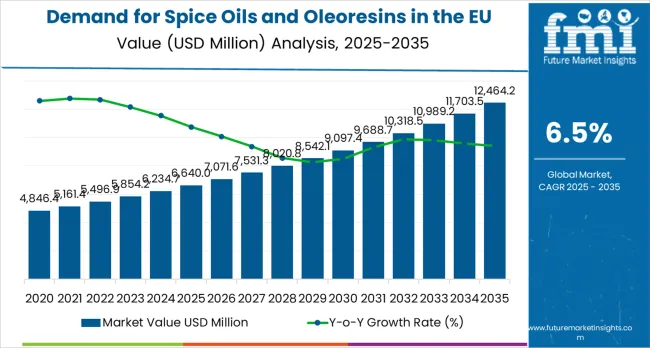
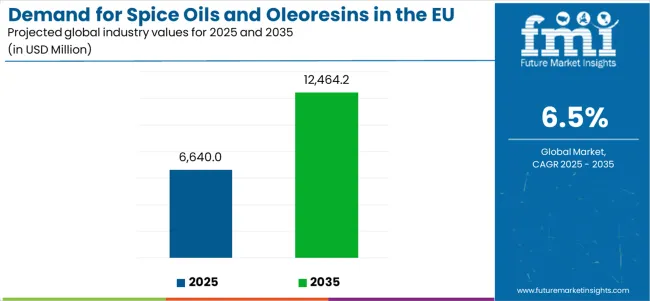
Between 2025 and 2030, EU spice oils and oleoresins demand is projected to expand from USD 6,640.0 million to USD 9,200.0 million, resulting in a value increase of USD 2,560.0 million, which represents 42.2% of the total forecast growth for the decade. This phase of development will be shaped by rising consumer adoption of natural food ingredients, increasing availability of diverse product varieties across food processing, pharmaceuticals, and cosmetics applications, and growing mainstream acceptance of natural flavoring and coloring agents across retail and industrial channels. Manufacturers are expanding their product portfolios to address the evolving preferences for clean-label formulations, authentic spice flavor profiles, and standardized oleoresin concentrations comparable to synthetic alternatives.
From 2030 to 2035, sales are forecast to grow from USD 9,200.0 million to USD 12464.2 million, adding another USD 3,500.0 million, which constitutes 57.8% of the overall ten-year expansion. This period is expected to be characterized by further expansion of pharmaceutical and nutraceutical applications, integration of advanced extraction technologies for improved purity and potency, and development of premium organic spice extracts targeting health-conscious consumer applications. The growing focus on natural wellness ingredients and increasing consumer willingness to pay premium prices for certified organic and sustainably sourced spice extracts will drive demand for innovative spice oils and oleoresins products that deliver authentic flavor experiences and functional health benefits.
Between 2020 and 2025, EU spice oils and oleoresins sales experienced robust expansion at a CAGR of 6.4%, growing from USD 4,880.0 million to USD 6,640.0 million. This period was driven by increasing demand for natural food additives among European consumers, rising awareness of synthetic flavoring concerns and artificial additive avoidance, and growing recognition of spice extract health benefits. The industry developed as major food companies and specialized flavor houses recognized the commercial potential of natural spice-based ingredients. Product innovations, improved extraction methodologies, and standardization efforts began establishing consumer confidence and mainstream acceptance of spice oils and oleoresins in processed food applications.
Industry expansion is being supported by the rapid increase in clean-label conscious consumers across European countries and the corresponding demand for natural, authentic, and health-conscious food ingredients with proven functionality in culinary and industrial applications. Modern food manufacturers rely on spice oils and oleoresins as direct replacements for synthetic flavorings and colorants in food processing, beverage formulation, pharmaceutical manufacturing, and cosmetic production, driving demand for products that match or exceed synthetic alternatives' functional properties, including heat stability, solubility characteristics, and flavor intensity. Even minor health concerns, such as synthetic additive sensitivity, artificial ingredient avoidance, or natural wellness preferences, can drive comprehensive adoption of spice oils and oleoresins to maintain optimal product quality and support clean-label formulation strategies.
The growing awareness of natural ingredient benefits and increasing recognition of synthetic flavoring health concerns are driving demand for spice oils and oleoresins from certified producers with appropriate quality credentials and green sourcing practices. Regulatory authorities are increasingly establishing clear guidelines for spice extract labeling, purity standards, and quality requirements to maintain consumer safety and ensure product consistency. Scientific research studies and analytical testing are providing evidence supporting spice oils and oleoresins' functional advantages and health-promoting properties, requiring specialized extraction methods and standardized processing protocols for authentic flavor development, optimal potency profiles, and appropriate chemical fingerprinting, including capsaicinoid content and piperine concentration verification.
Sales are segmented by product type, application, and nature. By product type, demand is divided into oleoresins and spice oils. Based on the application, sales are categorized into food and beverages (including bakery and confectionery, beverages, dressings and condiments), cosmetics and personal care, pharmaceuticals, dietary supplements, and others. By nature, sales are classified into conventional and organic. Regionally, demand is focused on Germany, France, Italy, Spain, the Netherlands, and the Rest of Europe.
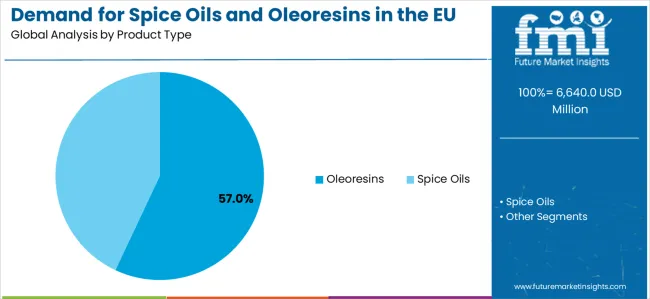
The oleoresins segment is projected to account for 57.0% of EU spice oils and oleoresins sales in 2025, establishing itself as the dominant product format across European markets. This commanding position is fundamentally supported by oleoresins' concentrated nature offering superior flavor intensity per unit weight, comprehensive composition retaining both volatile and non-volatile spice components, and superior functional properties enabling standardized flavor delivery and extended shelf stability. The oleoresin format delivers exceptional versatility, providing food manufacturers with a reliable flavoring agent that facilitates consistent batch-to-batch performance, reduced storage requirements compared to whole spices, and superior heat stability essential for processed food applications.
This segment benefits from mature extraction technologies, well-established processing infrastructure, and extensive availability from multiple certified European and international suppliers who maintain rigorous quality standards and organic certifications. The oleoresins offer versatility across various applications, including meat processing, snack seasoning, sauce manufacturing, and beverage flavoring, supported by proven formulation technologies that address traditional challenges in flavor standardization and microbiological safety.
The oleoresins segment is expected to grow its share to 60.0% by 2035, demonstrating continued dominance as food manufacturers increasingly prioritize concentrated flavor formats offering operational efficiency, cost-effectiveness, and superior quality control throughout the forecast period.
Key advantages:
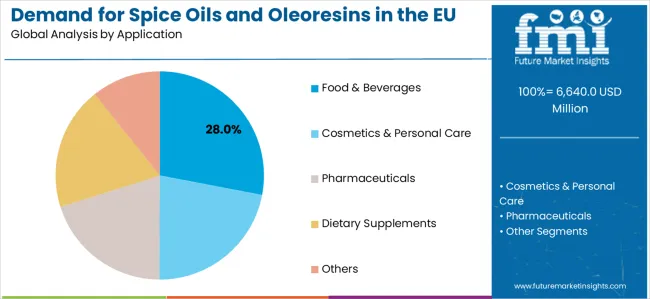
Food and beverages application is positioned to represent 28.0% of total spice oils and oleoresins demand across European markets in 2025, with this share projected to decrease slightly to 26.0% by 2035, reflecting the segment's established position as the largest single application within the overall industry ecosystem. This substantial share directly demonstrates that food and beverage manufacturers represent the primary consumer base, with processors utilizing spice extracts for meat seasoning, snack flavoring, ready-meal preparation, sauce manufacturing, and beverage formulation applications requiring authentic spice characteristics and heat-stable flavor profiles.
Modern food manufacturers increasingly view spice oils and oleoresins as essential clean-label ingredients, driving demand for products optimized for various processing conditions with appropriate solubility characteristics, flavor profiles that appeal to diverse consumer demographics, and formulations that maintain flavor integrity throughout product shelf life. The segment benefits from continuous product innovation focused on improved flavor masking for functional foods, texture enhancement preventing grittiness in applications, and flavor development eliminating harsh notes associated with raw spice materials.
Within food and beverages, bakery and confectionery accounts for 12.0% share, beverages represent 9.0%, and dressings and condiments constitute 8.0% of total market demand in 2025.
Key drivers:
Conventional spice oils and oleoresins products are strategically positioned to contribute 55.0% of total European sales in 2025, with this share decreasing to 50.0% by 2035, representing products produced through standard agricultural and extraction methods without organic certification requirements. These conventional products successfully deliver accessible pricing and consistent quality while ensuring broad commercial availability across all industrial channels and food processing operations that prioritize volume scalability and cost competitiveness over organic certification.
Conventional production serves price-conscious food manufacturers, mainstream industrial applications, and large-volume processing operations, including spice blend manufacturers, seasoning companies, and institutional food producers that require reliable supply at competitive price points. The segment derives significant competitive advantages from established ingredient supply chains, economies of scale in extraction processing, and the ability to meet substantial volume requirements from major food processors and flavor houses without organic certification constraints limiting spice raw material sourcing options.
The segment's decreasing share from 55.0% to 50.0% by 2035 reflects the growing organic segment driven by consumer preference shifts toward certified organic ingredients, with conventional products maintaining parity position while continuing to serve mainstream industrial applications requiring cost-effective natural flavoring solutions.
Key advantages:
EU spice oils and oleoresins sales are advancing rapidly due to accelerating clean-label food trends, growing synthetic additive avoidance, and increasing consumer preference for natural flavoring agents. The industry faces challenges, including volatile raw material pricing influenced by agricultural commodity markets and weather conditions, supply chain complexity involving multiple origin countries with varying quality standards, and regulatory constraints on health claim substantiation for spice bioactive compounds. Continued innovation in extraction technologies and supply chain optimization remains central to industry development.
The rapidly accelerating development of supercritical carbon dioxide extraction technologies is fundamentally transforming spice oils and oleoresins production from traditional solvent extraction to environmentally friendly processing methods, enabling superior purity profiles and enhanced bioactive retention previously unattainable through conventional extraction techniques. Advanced supercritical fluid extraction platforms featuring precise pressure and temperature control produce spice extracts with zero solvent residues, superior volatile compound retention, and enhanced bioactive concentration, allowing manufacturers to create premium spice oils with authentic flavor characteristics, extended shelf stability, and clean-label positioning appealing to health-conscious consumers and quality-focused food manufacturers.
These green extraction innovations prove particularly transformative for premium applications, including organic spice extracts, pharmaceutical-grade oleoresins, and nutraceutical ingredients, where solvent-free processing proves essential for regulatory compliance and consumer acceptance. Major spice extract producers invest heavily in supercritical CO2 equipment, pilot-scale processing development, and analytical validation for extract quality verification, recognizing that green extraction technologies represent breakthrough solutions for quality differentiation and premium market positioning.
Modern spice oils and oleoresins producers systematically incorporate blockchain-based traceability platforms and digital supply chain management systems that deliver complete transparency from spice cultivation through extraction processing to final product distribution, supporting origin verification, quality assurance documentation, and eco-friendly claim substantiation. Strategic integration of digital traceability technologies enables manufacturers to position spice extracts as premium ingredients with verified sourcing credentials, authentic origin documentation, and comprehensive quality history, addressing food processor concerns regarding adulteration risks, quality consistency, and regulatory compliance requirements.
These traceability improvements prove essential for pharmaceutical and nutraceutical applications, as quality managers demand complete ingredient history, batch-specific analytical data, and supplier audit documentation supporting good manufacturing practice compliance. Companies implement comprehensive digital platforms, supplier certification programs, and third-party verification systems targeting specific applications, including pharmaceutical oleoresins requiring complete chain-of-custody documentation, organic spice oils necessitating certified organic verification throughout supply chains, and geographical indication products demanding origin authentication and traditional processing validation.
European food manufacturers and consumers increasingly prioritize eco-friendly sourced spice oils and oleoresins featuring fair trade certification, environmental stewardship verification, and transparent farmer partnership programs that align with corporate social responsibility commitments. This sustainability trend enables spice extract producers to differentiate premium offerings through certified eco-friendly sourcing, farmer welfare programs, and environmental impact reduction claims that resonate with ethically conscious food brands seeking responsible ingredient sourcing supporting brand values and consumer expectations.
Green sourcing positioning proves particularly important for retail brand applications where corporate sustainability reporting requires verifiable environmental and social impact metrics justifying premium ingredient costs and supporting marketing claims related to ethical sourcing and farmer support. The development of direct farmer partnerships, cooperative sourcing models, and long-term contract farming arrangements expands producers' abilities to secure stable supply while supporting rural livelihoods and environmental conservation in spice cultivation regions.
EU spice oils and oleoresins sales are projected to grow from USD 6,640.0 million in 2025 to USD 12464.2 million by 2035, registering a CAGR of 6.5% over the forecast period. Germany is expected to demonstrate the strongest growth trajectory among major markets with a 7.8% CAGR, supported by advanced food processing infrastructure, a strong pharmaceutical industry, and established flavor houses. France follows with a 7.3% CAGR, attributed to sophisticated culinary traditions and premium food positioning.
Germany maintains the largest share at 32.1% in 2025 (USD 2,130.0 million), reflecting market maturity and established industrial infrastructure. France represents 23.3% share, while Italy accounts for 12.7%, Spain 8.1%, Netherlands 3.6%, and Rest of Europe 20.2%.
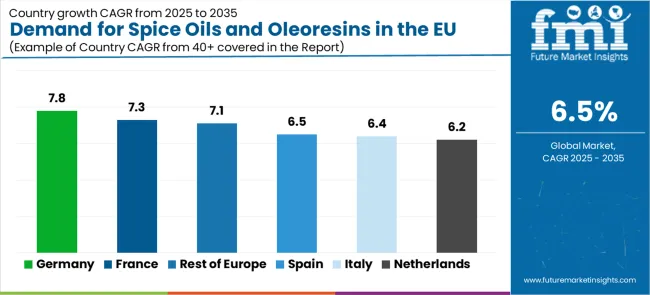
| Country | CAGR % (2025-2035) |
|---|---|
| Germany | 7.8% |
| France | 7.3% |
| Rest of Europe | 7.1% |
| Spain | 6.5% |
| Italy | 6.4% |
| Netherlands | 6.2% |
EU spice oils and oleoresins sales demonstrate strong growth across major European economies, with Germany leading expansion at 7.8% CAGR through 2035, driven by advanced food processing capabilities and pharmaceutical industry demand. France benefits from premium culinary positioning and sophisticated flavor applications. Italy leverages traditional food culture and growing clean-label trends. Spain shows steady growth supported by expanding food processing sector and tourism-driven hospitality industry. The Netherlands prioritizes food technology innovation and green ingredient development. Sales show robust regional development reflecting EU-wide shifts toward natural ingredients and clean-label food formulations.
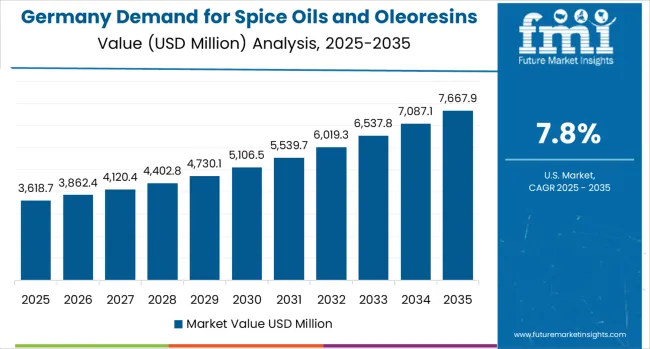
Revenue from spice oils and oleoresins in Germany is projected to exhibit robust growth with a CAGR of 7.8% through 2035, driven by exceptionally well-developed food processing infrastructure, comprehensive pharmaceutical manufacturing capabilities, and strong flavor industry presence throughout the country. Germany's sophisticated food technology expertise and internationally recognized leadership in ingredient innovation are creating substantial demand for diverse spice extract varieties across all industrial segments.
Major food processors, including flavor houses, meat processors, and confectionery manufacturers, systematically expand spice oils and oleoresins utilization, leveraging advanced formulation capabilities and quality assurance systems supporting premium product positioning. German demand benefits from strong pharmaceutical industry requiring high-purity oleoresins, substantial research and development investment supporting extraction technology advancement, and cultural appreciation for authentic flavor profiles that naturally supports spice extract adoption across industrial food production.
Key drivers:
Revenue from spice oils and oleoresins in France is expanding at a CAGR of 7.3%, substantially supported by sophisticated culinary culture demanding superior ingredient quality and authentic flavor profiles despite France's traditional preference for whole spices in artisanal cooking. France's growing food processing industry and increasing clean-label requirements are systematically driving demand for high-quality spice extracts across diverse application segments.
Major food manufacturers, including sauce producers, prepared meal companies, and specialty food brands, are establishing comprehensive spice extract programs to serve continuously growing demand for natural flavoring solutions. French sales particularly benefit from sophisticated consumer expectations demanding superior taste and quality standards, driving product innovation and premiumization within the spice oils and oleoresins category. Premium positioning focus and artisanal food culture significantly enhance adoption rates in high-value food applications.
Key drivers:
Revenue from spice oils and oleoresins in Italy is growing at a solid CAGR of 6.4%, fundamentally driven by traditional food culture focusing authentic flavors, expanding processed food sector, and gradual modernization of ingredient sourcing practices. Italy's food processing industry is increasingly adopting standardized spice extracts while maintaining traditional flavor profiles and authentic Mediterranean taste characteristics.
Major food manufacturers, including pasta sauce producers, meat processors, and seasoning companies, strategically invest in spice extract utilization for quality standardization and shelf-life extension while preserving traditional flavor authenticity. Italian sales particularly benefit from strong export-oriented food industry requiring consistent flavor profiles, combined with growing clean-label requirements from international customers driving natural ingredient adoption.
Key drivers:
Revenue from spice oils and oleoresins in Spain is projected to grow at a CAGR of 6.5% (2025 to 2035), supported by the expanding food processing sector and tourism-driven hospitality industry. Spain’s culinary culture emphasizes bold, Mediterranean-inspired flavors, which aligns with growing demand for concentrated natural spice extracts in both domestic and export-oriented food production.
The Spanish foodservice industry, heavily influenced by international tourism, increasingly incorporates standardized flavoring solutions to maintain consistency across large-scale hotel, restaurant, and catering operations. Growth in Spain’s packaged foods and ready-meal segments creates steady demand for spice oils and oleoresins, particularly in sauces, seasonings, and meat products.
Key drivers:
Revenue from spice oils and oleoresins in the Netherlands is forecast to grow at a CAGR of 6.2% (2025 to 2035), with growth underpinned by the country’s strong food technology innovation ecosystem and focus on eco-friendly ingredient sourcing. Dutch companies are leaders in food R&D and are increasingly incorporating spice extracts into innovative flavor systems, plant-based food alternatives, and health-oriented product formulations.
The Netherlands serves as a logistics and innovation hub for food ingredients across Europe, with strong distribution networks that facilitate the adoption of spice oils and oleoresins across regional markets. Growing consumer demand for sustainable, clean-label, and functional food products also positions the Netherlands as an influential market in shaping EU-wide adoption trends.
Key drivers:
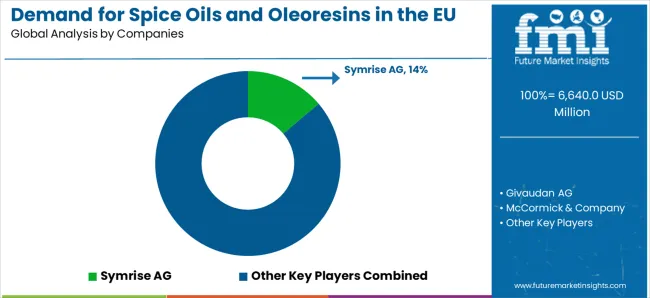
EU spice oils and oleoresins sales are defined by competition among multinational ingredient suppliers, specialized extraction companies, and integrated spice processors. Companies are investing in advanced extraction technologies, supply chain traceability systems, quality standardization programs, and green initiatives to deliver high-quality, consistently performing, and responsibly sourced spice extract solutions. Strategic partnerships with spice cultivators, food processor collaboration programs, and technical service capabilities focusing application support are central to strengthening market position.
Major participants include Symrise AG with an estimated 14.0% share, leveraging its German operational base, comprehensive flavor development capabilities, and established European food industry relationships, supporting consistent supply to food manufacturers and flavor houses. Symrise benefits from integrated spice processing operations, technical application support services, and the ability to provide customized flavor solutions, including spice blends, natural flavoring systems, and functional extracts, supporting customer product development requirements.
Givaudan AG holds approximately 12.0% share, focusing comprehensive flavor portfolio spanning multiple food applications, strong research and development infrastructure, and global sourcing capabilities ensuring reliable supply. Givaudan's success in developing innovative flavor systems combining spice extracts with complementary natural ingredients creates strong positioning and premium market access, supported by Swiss quality reputation and extensive technical expertise.
McCormick & Company accounts for roughly 9.0% share through its position as an integrated spice company, providing both consumer products and industrial ingredients to food processors. The company benefits from vertical integration controlling spice sourcing through final extract production, established supplier relationships with spice-growing regions, and comprehensive quality assurance systems, helping manufacturers source reliable spice extracts with consistent specifications.
Synthite Industries represents approximately 6.0% share, supporting growth through specialized focus on spice extract production, direct sourcing from Indian spice cultivation regions, and competitive pricing enabled by integrated operations. Synthite leverages large-scale extraction infrastructure, proprietary processing technologies, and comprehensive product portfolio including oleoresins, essential oils, and natural colorants, attracting cost-conscious food processors seeking reliable supply and competitive pricing.
Other companies and regional processors collectively hold 59.0% share, reflecting the moderately fragmented nature of European spice oils and oleoresins sales, where numerous specialized extraction companies, regional spice processors, integrated food ingredient suppliers, and emerging green extraction technology providers serve specific applications, geographic markets, and quality tiers. This fragmentation provides opportunities for differentiation through specialized extraction methods (supercritical CO2, organic certified), premium quality positioning (pharmaceutical-grade, specialty cultivars), eco-friendly credentials (fair trade, organic), and technical service capabilities supporting customer application development and formulation optimization.
| Item | Value |
|---|---|
| Quantitative Units | USD 12,700.0 million |
| Product Type | Oleoresins, Spice Oils |
| Application | Food & Beverages (Bakery & Confectionery, Beverages, Dressings & Condiments), Cosmetics & Personal Care, Pharmaceuticals, Dietary Supplements, Others |
| Nature | Conventional, Organic |
| Countries Covered | Germany, France, Italy, Spain, Netherlands, Rest of Europe |
| Key Companies Profiled | Symrise AG, Givaudan AG, McCormick & Company, Synthite Industries, Firmenich SA, IFF, Sensient Technologies, Kancor Ingredients, Plant Lipids, Regional processors |
| Additional Attributes | Dollar sales by product type, application, and nature; regional demand trends across major European markets; competitive landscape analysis with established ingredient suppliers and specialized extraction companies; customer preferences for various extract formats and applications; integration with green extraction technologies and traceability systems; innovations in quality standardization and supply chain transparency; adoption across food processing, pharmaceutical, cosmetic, and nutraceutical channels; regulatory framework analysis for spice extract specifications and organic certification; supply chain strategies; and penetration analysis for mainstream food manufacturers and premium ingredient applications. |
The global demand for spice oils and oleoresins in the EU is estimated to be valued at USD 6,640.0 million in 2025.
The market size for the demand for spice oils and oleoresins in the EU is projected to reach USD 12,464.2 million by 2035.
The demand for spice oils and oleoresins in the EU is expected to grow at a 6.5% CAGR between 2025 and 2035.
The key product types in demand for spice oils and oleoresins in the EU are oleoresins and spice oils.
In terms of application, food & beverages segment to command 28.0% share in the demand for spice oils and oleoresins in the EU in 2025.






Our Research Products

The "Full Research Suite" delivers actionable market intel, deep dives on markets or technologies, so clients act faster, cut risk, and unlock growth.

The Leaderboard benchmarks and ranks top vendors, classifying them as Established Leaders, Leading Challengers, or Disruptors & Challengers.

Locates where complements amplify value and substitutes erode it, forecasting net impact by horizon

We deliver granular, decision-grade intel: market sizing, 5-year forecasts, pricing, adoption, usage, revenue, and operational KPIs—plus competitor tracking, regulation, and value chains—across 60 countries broadly.

Spot the shifts before they hit your P&L. We track inflection points, adoption curves, pricing moves, and ecosystem plays to show where demand is heading, why it is changing, and what to do next across high-growth markets and disruptive tech

Real-time reads of user behavior. We track shifting priorities, perceptions of today’s and next-gen services, and provider experience, then pace how fast tech moves from trial to adoption, blending buyer, consumer, and channel inputs with social signals (#WhySwitch, #UX).

Partner with our analyst team to build a custom report designed around your business priorities. From analysing market trends to assessing competitors or crafting bespoke datasets, we tailor insights to your needs.
Supplier Intelligence
Discovery & Profiling
Capacity & Footprint
Performance & Risk
Compliance & Governance
Commercial Readiness
Who Supplies Whom
Scorecards & Shortlists
Playbooks & Docs
Category Intelligence
Definition & Scope
Demand & Use Cases
Cost Drivers
Market Structure
Supply Chain Map
Trade & Policy
Operating Norms
Deliverables
Buyer Intelligence
Account Basics
Spend & Scope
Procurement Model
Vendor Requirements
Terms & Policies
Entry Strategy
Pain Points & Triggers
Outputs
Pricing Analysis
Benchmarks
Trends
Should-Cost
Indexation
Landed Cost
Commercial Terms
Deliverables
Brand Analysis
Positioning & Value Prop
Share & Presence
Customer Evidence
Go-to-Market
Digital & Reputation
Compliance & Trust
KPIs & Gaps
Outputs
Full Research Suite comprises of:
Market outlook & trends analysis
Interviews & case studies
Strategic recommendations
Vendor profiles & capabilities analysis
5-year forecasts
8 regions and 60+ country-level data splits
Market segment data splits
12 months of continuous data updates
DELIVERED AS:
PDF EXCEL ONLINE
Spice Oils and Oleoresins Market Analysis - Size, Share, and Forecast Outlook 2025 to 2035
Therapeutic Drug Monitoring Market Analysis - Size, Share, and Forecast Outlook 2025 to 2035
Therapeutic Robots Market Size and Share Forecast Outlook 2025 to 2035
Therapeutic Apheresis Market Analysis - Size, Share, and Forecast Outlook 2025 to 2035
Therapeutic Respiratory Devices Market Overview - Trends & Forecast 2025 to 2035
Therapeutic Contact Lenses Market Report - Trends, Demand & Outlook 2025 to 2035
Therapeutic Diet for Pet Market Analysis by Age Group, Health Condition, Distribution Channel and Others Through 2035
Therapeutic Hair Oil Market Insights - Size, Trends & Forecast 2025 to 2035
Therapeutic Nuclear Medicine Market Analysis – Size, Share & Forecast 2024-2034
Leukemia Therapeutics Treatment Market Analysis - Growth & Forecast 2025 to 2035
Competitive Overview of Neuroprosthetics Companies
Europe Radiotherapy Patient Positioning Market Size and Share Forecast Outlook 2025 to 2035
Northern Europe Calcium Sulphate Market Size and Share Forecast Outlook 2025 to 2035
Biotherapeutics Virus Removal Filters Market Trends – Growth & Forecast 2025 to 2035
Europe Massage Therapy Service Market Size and Share Forecast Outlook 2025 to 2035
Pain Therapeutic Injectables Market Size and Share Forecast Outlook 2025 to 2035
Pain Therapeutic Solutions Market Size and Share Forecast Outlook 2025 to 2035
COPD Therapeutics Market Report – Growth, Demand & Industry Forecast 2023-2033
Europe Herbs and Spices Market Analysis – Size, Share & Forecast 2025–2035
Psychotherapeutic Combinations Market Analysis - Size, Share, and Forecast Outlook 2025 to 2035

Thank you!
You will receive an email from our Business Development Manager. Please be sure to check your SPAM/JUNK folder too.
Chat With
MaRIA